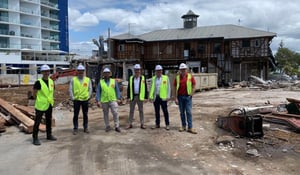In today's fast-paced and complex world, more than traditional approaches to safety is required to manage the risks that organisations face. To truly ensure safety in the modern world, organisations need a new system that is flexible, adaptable, and resilient.
Safety II recognises that accidents and failures are inevitable.
Safety II is a concept in the field of safety management that emphasises the role of resilience and adaptability in managing risk and ensuring safety. While traditional approaches to safety, known as Safety I, focus on preventing accidents and eliminating hazards, Safety II recognises that accidents and failures are inevitable and that organisations must adapt and recover from these events to maintain safety.
Safety II emphasises the importance of building resilience in systems and processes to ensure they can cope with unexpected events and continue functioning safely. This can involve designing systems with built-in redundancies, developing robust recovery processes, and fostering a culture of continuous learning and improvement.
One key aspect of Safety II recognises that people are an essential part of any safety system. Rather than viewing people as the weakest link in the design, Safety II acknowledges that employees are often the first line of defence against accidents and incidents and can adapt and respond to unexpected events. This means that organisations must create a culture that encourages employees to speak up about safety concerns and to actively participate in improving safety within the organisation.
There are several benefits to adopting a Safety II approach. First and foremost, Safety II can help organisations improve safety and reduce the risk of accidents and incidents. By building resilience in systems and processes and fostering a culture of continuous learning and improvement, organisations can better anticipate and respond to unexpected events and maintain safety in the face of changing conditions.
Safety II can also lead to increased efficiency and productivity.
Safety II can also lead to increased efficiency and productivity. By adopting a proactive approach to safety, organisations can identify and eliminate waste and inefficiencies and create more streamlined and efficient processes.Furthermore, Safety II can help organisations improve customer satisfaction and build stronger relationships with stakeholders. Organisations can build trust and credibility with customers, employees, and other stakeholders by demonstrating a commitment to safety and a proactive approach to managing risk.
Developing initiatives to implement a Safety II approach can be challenging, but it is essential for the well-being of employees and the organisation's overall success. Here are five steps that organisations can follow to implement Safety II:
- Foster a continuous learning and improvement culture: Encourage employees to learn from failures and incidents and create an environment in which it is safe to report and discuss near misses and other safety concerns.
- Design systems with built-in redundancies: Look for ways to build redundancies and other forms of resilience into processes and procedures so that they can continue to function safely even in the event of an unexpected failure.
- Develop robust recovery processes: Create plans and procedures for quickly and effectively recovering from incidents and failures, and regularly test and practice these processes to ensure they are effective.
- Encourage open communication: Promote open and honest communication about safety concerns and incidents, and encourage employees to speak up if they see something that could be dangerous.
- Invest in training and education: Provide employees with the training and education they need to understand and manage risk and encourage them to take an active role in improving safety within the organisation.
In conclusion, Safety II is a new approach to managing risk that emphasises the role of system resilience and adaptability in ensuring safety. By building strength in systems and processes, fostering a culture of continuous learning and improvement, and involving employees in the safety process, organisations can improve safety, increase efficiency, and build stronger relationships with stakeholders. If your organisation is looking to improve its safety performance, consider adopting a Safety II approach.
If your organisation is interested in implementing a Safety II approach, our consulting services can help. Our team of experienced safety professionals has a proven track record of assisting organisations to improve their safety performance and build resilience into their systems and processes.
We offer various innovative safety consulting services, including safety culture assessments, safety management system design and implementation, and training and education programs. Our team will work with you to understand your specific needs and develop a customised solution that fits your organisation's unique culture and challenges.
Don't let the complexity and uncertainty of the modern world put your organisation's safety at risk. Contact us today to learn more about how our consulting services can help your organisation adopt a Safety II approach and improve its safety performance.


